Why you can trust Tom's Hardware
Our standard benchmarks and power tests are performed using the CPU’s stock frequencies (including any default boost/turbo), with all power-saving features enabled. We set optimized defaults in the BIOS and the memory by enabling the XMP profile. For this baseline testing, the Windows power scheme is set to balanced (default), so the PC idles appropriately.
To get the most out of the Intel Alder Lake chips, you need to be on Windows 11 with its updated scheduler. In most cases, Windows 10 performs well. However, some tests (Cinebench R20, Corona and POVRay) take a significant hit. In short, if you’re going with Alder Lake, you must upgrade to Windows 11 for the best results across the board. That may change with patching and updates in the future, though.
Synthetic Benchmarks
Synthetics provide a great way to determine how a board runs, as identical settings should produce similar performance results. Turbo boost wattage and advanced memory timings are places where motherboard makers can still optimize for either stability or performance, though, and those settings can impact some testing.





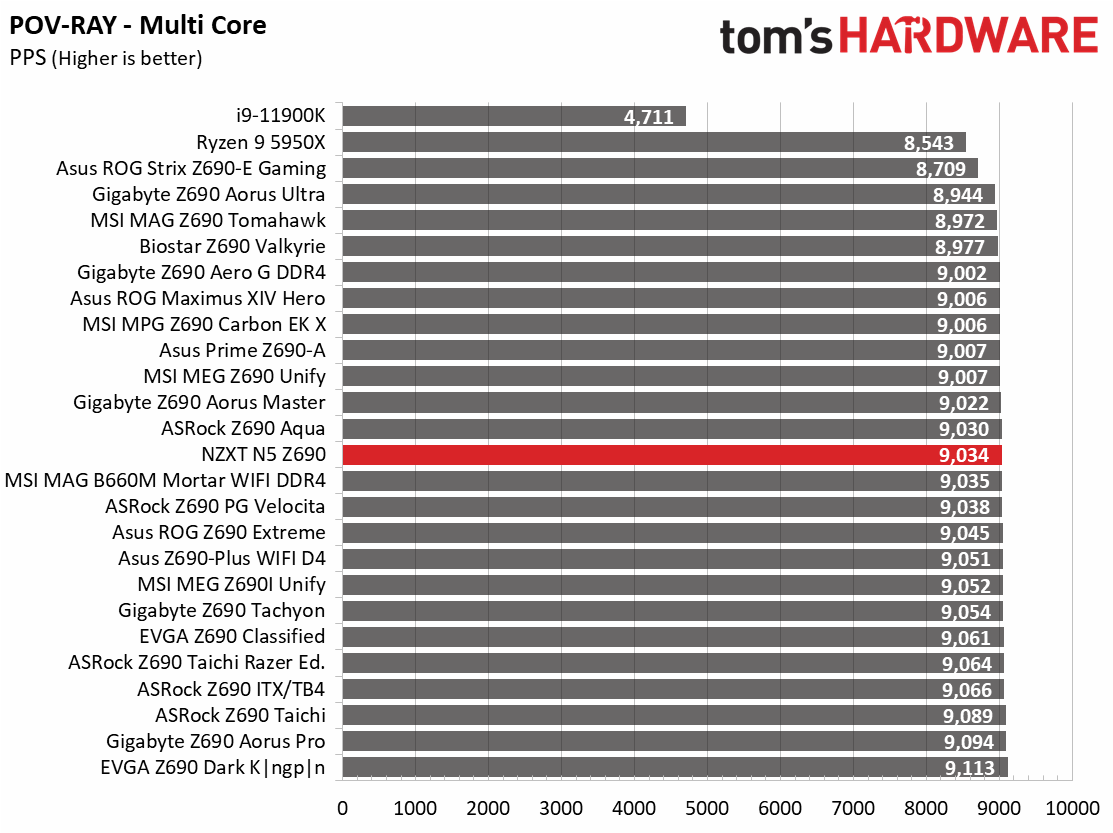



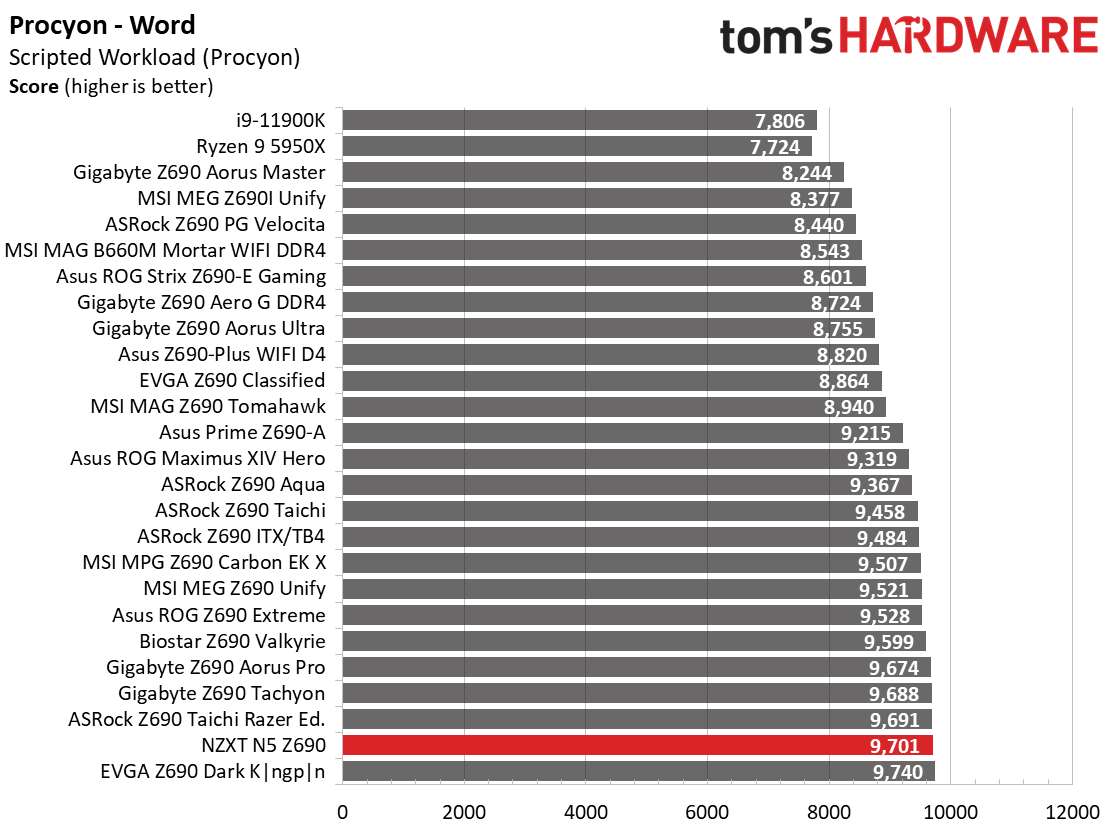


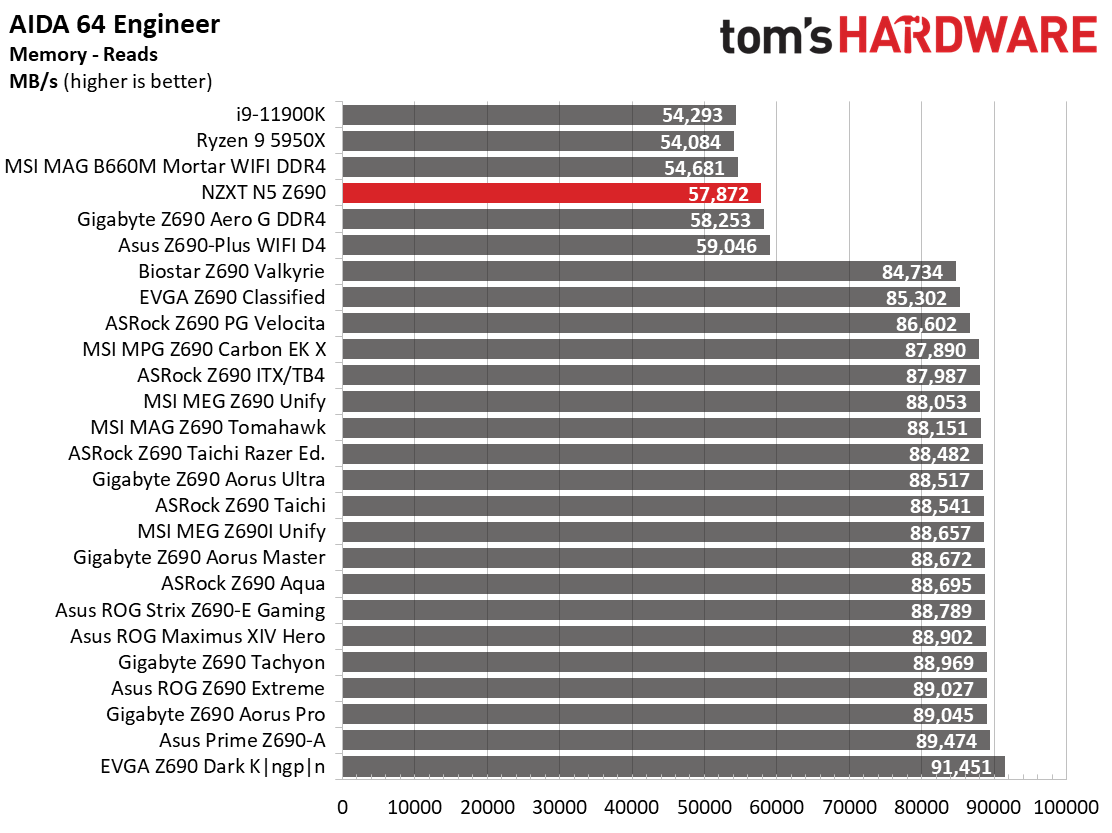



Results in our synthetic benchmarks were average to slightly below average for DDR4-based results. POV-Ray showed a solid result, as did the Procyon Office tests. However, the rest tested a bit slower than other like boards. That said, the results here aren’t far off from the mean, so it’s not like any aspect is way out of whack.
Timed Applications
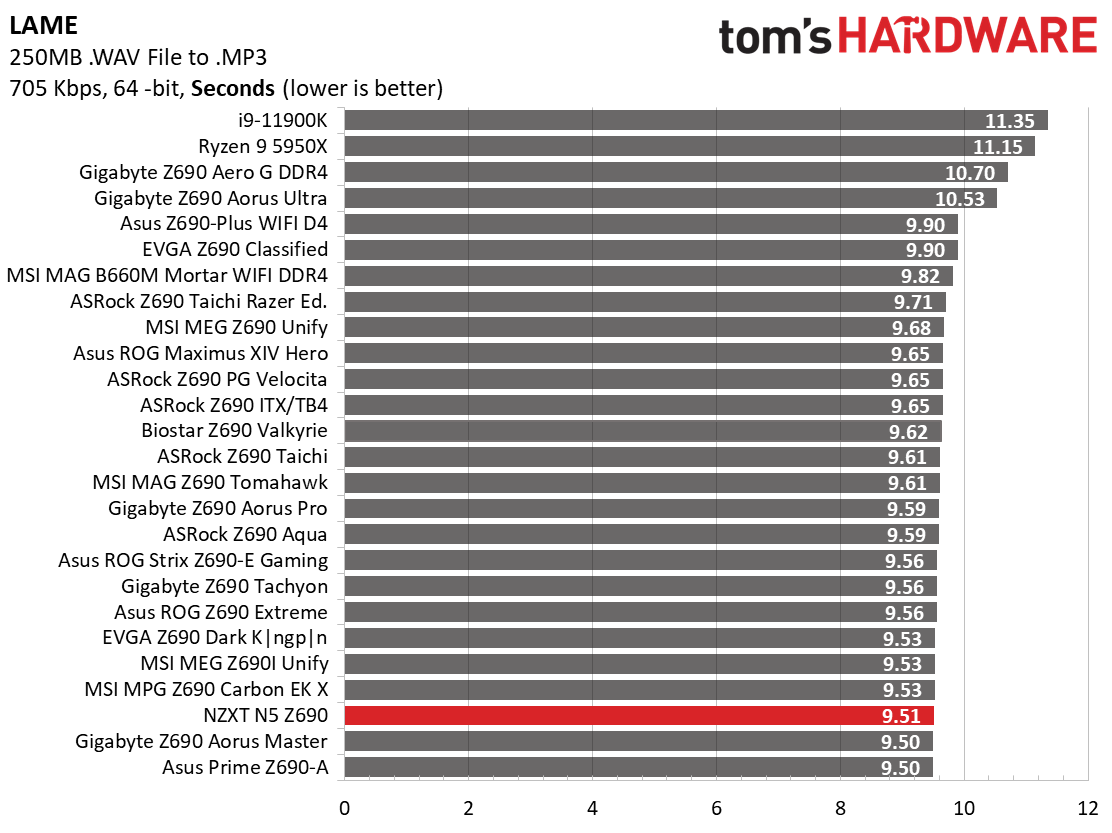



In our timed applications, the N5 did well overall, showing good results in Corona (52 seconds is average), and our LAME test was the 2nd fastest so far. On the other hand, both Handbrake tests were some of the slowest we’ve seen on this platform. In any heavily multi-threaded tests, the board seems to struggle more than others. It ran at 4.8 GHz during our stress testing (as opposed to 4.9 GHz like most other boards), which is a big part of why some tests were slower.
3D Games and 3DMark


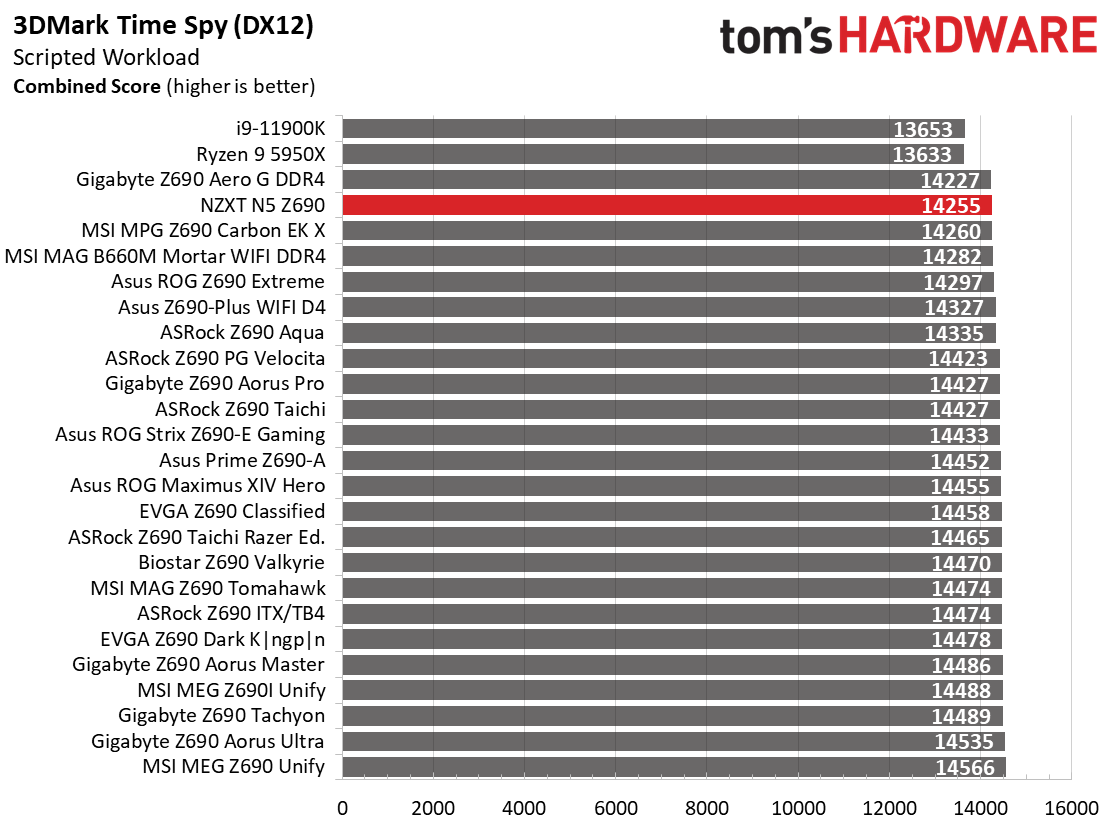

Starting with the launch of the Z690 chipset, we’ve updated our game tests, switching to Far Cry 6 and shifting from F1 2020 to F1 2021. We run the games at 1920x1080 resolution using the Ultra preset (details listed above). As the resolution goes up, the CPU tends to have less impact. The goal with these settings is to determine if there are differences in performance at the most commonly used resolution with settings most people use or strive for. We expect the difference between boards in these tests to be minor, with most falling within the margin of error differences. We’ve also added a minimum FPS value, as that can affect your gameplay and immersion experience.
In F1 2021, the N5 Z690 averaged 164 frames per second (fps) with minimums of 140 fps, an average result. In Far Cry 6, results were also average at 137 fps, with the minimum right up there with the rest. In the synthetic benchmarks, the board scored 14,255 in Time Spy and 16,949 in Fire Strike Extreme. The Time Spy results were lower than average, but Fire Strike was right in line. If you plan to game on this motherboard, it’s just as fast as others.
Get Tom's Hardware's best news and in-depth reviews, straight to your inbox.
Power Consumption / VRM Temperatures
We used AIDA64’s System Stability Test with Stress CPU, FPU and Cache enabled for power testing, using the peak power consumption value. The wattage reading is from the wall via a Kill-A-Watt meter to capture the entire PC minus the monitor. The only variable that changes is the motherboard; all other parts are the same.
At idle, the N5 consumed 55W, which is on the good side of average among similar Z690 boards. Load wattage peaked at 326W, also around the average of these overclocking-capable boards. There’s nothing out of line when it comes to power consumption here.




During stock stress testing, for the first time since the EVGA Z690 Dark K|ngP|n, we didn’t run into thermal throttling! This is one of the rare few boards not to throttle the processor out of the box due to high temperatures. VRM temperatures were hot, reaching nearly 80 degrees Celsius when overclocked. Those temperatures are within specification for the MOSFETs, but not by much. Keep some good airflow across the VRMs if you plan on pushing this system with all cores and threads.
Overclocking
Overclocking with Alder Lake is slightly different from what we’re used to due to the hybrid core configuration. Now, you can overclock the P and E cores separately, though they both use the same voltage domain. You can push one and not the other, or both, so there’s some flexibility. We set an overclock to 5.1 GHz across all P-cores and 4.1Ghz on all E-cores. This yields a 200 MHz bump on the P-cores and a 400 MHz increase on the E-cores. We’re topped out on the P-cores, primarily due to temperatures, but the more efficient E-cores still have some headroom.
Overclocking our Intel Core i9-12900K with the N5 proved easy as any other board. We manually set our voltage, and off we went. We ended up using LLC1 with a Vcore of 1.275V. According to CPU, we ended up with 1.257V. There’s still some vdroop left even with the LLC cranked, but that’s almost expected with the VRM configuration. Also worth noting: The MOSFETs ran hot, approaching 80 degrees Celsius, which is still in spec. But again, if you’re overclocking heavily, be sure to have good airflow inside the chassis.
On the memory side, we dropped our GSkill DDR4-4000 sticks in, enabled XMP, and went off without issue. Of course, the middling DDR4-3600 kit worked fine for our testing too. NZXT lists support to well over value-focused speeds, so we expect there’s some headroom left if you want to push the memory higher.
Bottom Line
Although the NZXT N5 Z690 arrived more than fashionably late to the Alder Lake party, the budget-class Z690 board walks in sporting NZXT’s signature style with an all-black PCB. And in the case of our ‘white’ N5, white accents (the N7 white is more white!). It looks much better than the Z690 Phantom Gaming 4 it looks to be based on, that’s for sure. But it’s not all about looks. NZXT’s board has a slew of M.2 storage, Wi-Fi 6E, and a sub-$240 price point that’s easy on the wallet.
Our testing showed the performance in most tests was average, with some slips in heavily threaded applications. Unless you’re grinding that type of workflow, you’d never know the N5 was on the slower side of average in some tests. That said, with some simple adjustments it’s just as performant in those tests as well. If gaming performance is a primary concern, there’s nothing to worry about right out of the box.
There are several boards around this price point, one from all the four major brands. ASRock has the Z690 Extreme ($239.99) and Asus the Prime Z690-P WiFi D4 ($224.99). Gigabyte offers the Z690 Aorus Elite AX DDR4 ($239.99), and MSI brings the MAG Z690 Tomahawk WIFI DDR4 ($259.99). All listed boards are more than capable of supporting our i9-12900K processor, including when overclocking. Some VRMs are better than others, but in the end, all of these options are limited by CPU cooling. The only board with four M.2 sockets to match the NZXT is the MSI Tomahawk. It also sports the best audio codec as well. The other board with Wi-Fi 6E like our N5 is ASRock’s Z690 Extreme. Only the Z690 Extreme and Z690 Aorus Elite have integrated RGBs. As usual, which is the best motherboard for you comes down to what you need for your system and what features you want the most. And of course, looks matter as well if you have a case with a window.
The NZXT N5 Z690 is an affordable option in the Z690 board space. While performance isn’t the best we’ve tested, you should only notice a difference in long-running, heavily multi-threaded tests. Gaming performance was spot on, as were all of the other tests. Hardware-wise, it has fast Wi-Fi 6E and plenty of M.2 storage. While the appearance may be a bit flat compared to others, it still makes for a lovely centerpiece for your build, especially inside one of NZXT’s chassis. If you’re looking to buy into Alder Lake without breaking the bank, especially if you prefer M.2 storage, the N5 is a solid option in the sub-$250 price range.
MORE: Best Motherboards
MORE: How To Choose A Motherboard
MORE: All Motherboard Content
MORE: Best Motherboards
MORE: How To Choose A Motherboard
MORE: All Motherboard Content

Joe Shields is a staff writer at Tom’s Hardware. He reviews motherboards and PC components.
-
Darkbreeze This is literally a board with no reason to exist. Another fine blunder by the folks at NZXT.Reply -
Co BIY ReplyDarkbreeze said:This is literally a board with no reason to exist. Another fine blunder by the folks at NZXT.
Why?
If this had come out earlier when Adler Lake was fresh I think this would be a popular option. 4 M.2 and no money wasted on RGB. -
Darkbreeze ReplyCo BIY said:Why?
Why? Because you can get a variety of motherboards that don't have these shortcomings,
No USB 3.2 Gen2x2 (20 Gbps)
Dated mid-range audio
Hot running, paltry 50A MOSFETs
for less than that board costs, and they not only look better but have additional options not found on that NZXT board.

